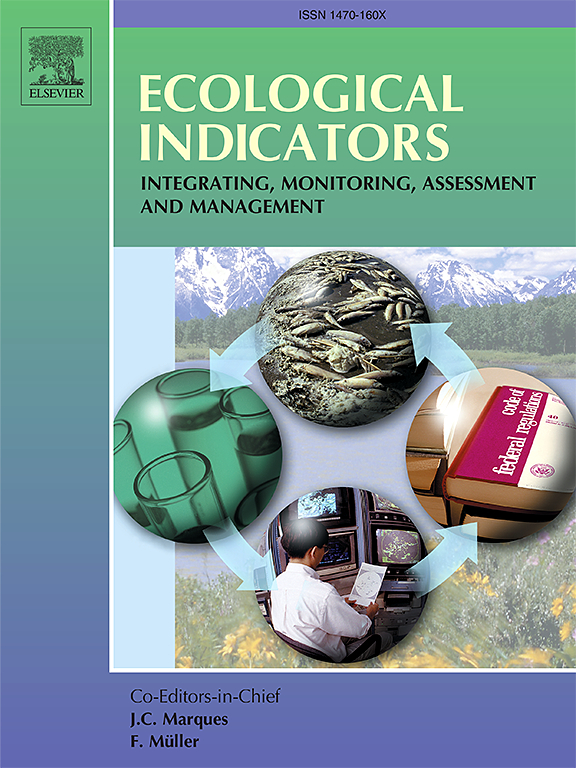基于蚁群优化的典型绿洲区生态安全格局构建——以伊犁河流域为例
IF 7
2区 环境科学与生态学
Q1 ENVIRONMENTAL SCIENCES
引用次数: 0
摘要
构建生态安全格局是实现社会与环境和谐发展的关键。目前,生态规划面临的主要挑战是大面积的连续生态源区和生态廊道宽度的准确确定。本研究利用InVEST-MSPA-Conefor模型、电路理论、MATLAB和ArcGIS平台,对伊犁河流域生态系统ESP进行分析,评价生境质量,识别生境斑块类型。结果表明:①河谷南部和东部生境质量较高;核心区占研究区面积的50.69%,对生态连通性至关重要。(2)生态抗性增强主要发生在山谷丘陵和交通要道附近。(3)共确定70个生态廊道,主要廊道面积3671.68 km2,潜在廊道面积6968.31 km2,将“源-线-点”分析扩展到“源-线-点-面”分析,加强了生态保护与管理策略。(4)基于ESP成果和地方政策,提出了“三带两轴一集群”优化管理策略。该研究促进了对伊犁河流域生态系统结构的认识,为生物多样性保护和生态服务优化提供了策略,并强调了综合、多维建模在生态规划中的价值。本文章由计算机程序翻译,如有差异,请以英文原文为准。
Ecological Security Pattern Construction in Typical Oasis Area Based on Ant Colony Optimization: A Case Study in Yili River Valley, China
Establishing Ecological Security Pattern (ESP) is crucial for the harmonious development of society and the environment. Currently, the principal challenges in ecological planning include large contiguous ecological source areas and the accurate determination of ecological corridor widths. This study utilized the InVEST-MSPA-Conefor model, circuit theory, MATLAB, and the ArcGIS platform to analyze the Yili River Valley’s ESP, assess habitat quality, and identify habitat patch types. Results indicate that: (1) Habitat quality is higher in the southern and eastern parts of the river valley. The core area, vital for ecological connectivity, constituted 50.69 % of the study area. (2) Increased ecological resistance was predominantly observed in valley hills and near major transportation routes. (3) Seventy ecological corridors were identified, covering 3671.68 km2 of major and 6968.31 km2 of potential corridors, thus expanding the analysis from “source-line-point” to “source-line-point-plane” and strengthening ecological protection and management strategies. (4) The study proposes an optimization and management strategy of “Three Belts, Two Axes, and One Cluster” grounded in ESP results and local policies. The study advances the understanding of the Yili River Valley’s ecosystem structure, provides strategies for biodiversity conservation and ecological service optimization, and emphasizes the value of integrated, multi-dimensional modeling in ecological planning.
求助全文
通过发布文献求助,成功后即可免费获取论文全文。
去求助
来源期刊

Ecological Indicators
环境科学-环境科学
CiteScore
11.80
自引率
8.70%
发文量
1163
审稿时长
78 days
期刊介绍:
The ultimate aim of Ecological Indicators is to integrate the monitoring and assessment of ecological and environmental indicators with management practices. The journal provides a forum for the discussion of the applied scientific development and review of traditional indicator approaches as well as for theoretical, modelling and quantitative applications such as index development. Research into the following areas will be published.
• All aspects of ecological and environmental indicators and indices.
• New indicators, and new approaches and methods for indicator development, testing and use.
• Development and modelling of indices, e.g. application of indicator suites across multiple scales and resources.
• Analysis and research of resource, system- and scale-specific indicators.
• Methods for integration of social and other valuation metrics for the production of scientifically rigorous and politically-relevant assessments using indicator-based monitoring and assessment programs.
• How research indicators can be transformed into direct application for management purposes.
• Broader assessment objectives and methods, e.g. biodiversity, biological integrity, and sustainability, through the use of indicators.
• Resource-specific indicators such as landscape, agroecosystems, forests, wetlands, etc.
 求助内容:
求助内容: 应助结果提醒方式:
应助结果提醒方式:


